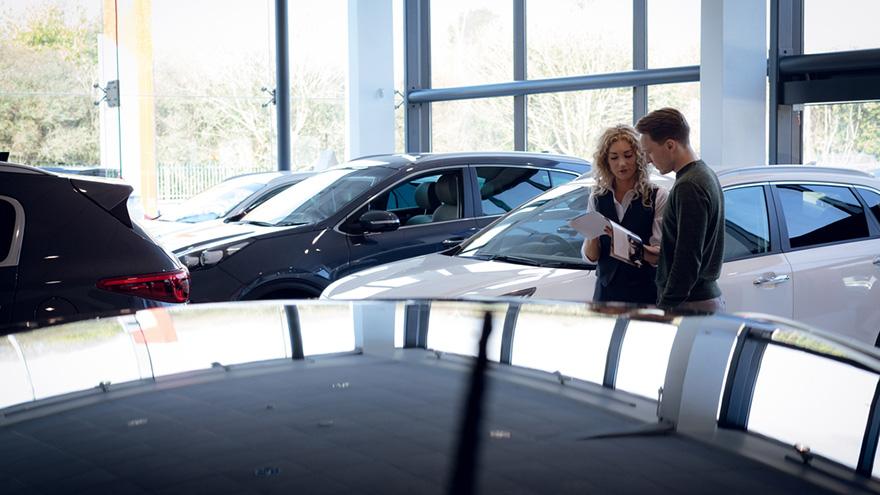Canadian auto lenders boost value for dealers amid challenging market

The J.D. Power 2022 Canada Dealer Financing Satisfaction Study analyzed the Canadian auto finance sector and, perhaps not surprisingly, found that supply-chain issues are affecting available inventory at auto dealerships in Canada.
Additionally, J.D Power said in a news release on the study, “it also means fewer new- and used-vehicle transactions during which lenders can provide a high level of service to dealers and deliver on their value proposition.”
The company reports that customer satisfaction increased across all four segments it tracks — retail-captive, retail-non-captive, non-captive non-prime, and lease — despite a sharp drop in new-vehicle sales.
In terms of supply-chain issues, Patrick Roosenberg, director of automotive finance intelligence at J.D. Power, told Auto Remarketing Canada that he does not see this issue resolving itself anytime soon.
He said manufacturers just cannot meet demand. But the auto industry may be adapting to a new normal.
Roosenberg said, “The new model moving forward is not a hundred days of inventory for the dealer. Those days are gone, in the manufacturers’ opinion. They’re experiencing fantastic margins, so they’re going to try to strike the right balance between demand and supply, pulling away from that traditional model of loading up the dealership with lots of cars.
“Those days are gone. We’re going to have a much more constrictive supply, and demand is obviously outpacing that supply at the moment,” he said.
And there are some storm clouds on the horizon for the lenders and other sectors of the automotive industry — outside of not having enough supply.
For example, incentives are drastically down.
“So, there’s a little more competitiveness between the lenders that have some agreements with the manufacturers and then those that don’t,” he said.
Leasing has dwindled, as well, Roosenberg pointed out, and this has historically been an incentive-heavy segment.
“At least in terms of incentivizing, opportunities have really reduced,” he said.
What are the ramifications down the line? Dealers are used to these leasing customers coming back into the dealership every two to three years.
“Now those customers are flipping to retail, and they’re flipping to extended-term loans … you’re seeing the 72-, the 84- and 96-month loans. They’re going to keep those customers out of the dealership for years,” Roosenberg said.
Customers are also buying their leases, because their vehicles are worth more than the buyout.
“If it’s worth three or four thousand (dollars) more than the buyout, customers are buying it, and then possibly selling it on their own,” he said.
This is primarily because lenders and manufacturers restrict who customers can sell those vehicles to — as every manufacturer wants to keep business within their respective captives.
“It makes sense if that car’s worth $5,000 more than the payoff; it makes sense to buy it,” he said. “But some dealers will still offer you a good price, above and beyond the agreed upon price at the end of the lease.”
Another factor impacting dealers and lenders is that first-time car buyers are being priced out of the market.
“Traditionally, a customer that would fit well with a used vehicle or a lease is getting priced out of those market,” he said. “And if you throw on the layer of a possible recession, whether that’s in the U.S. or Canada, that is going to restrict the ability for customers to buy a vehicle.”
This is putting pressure on lenders to ramp up their services to dealers.
“Cars are more expensive. So, it’s really up to lenders to differentiate themselves by the levels of service they provide to their dealers to be able to capture those deals that are fewer and farther between,” Roosenberg said.
Dealers are also looking for a more digital experience, whether that’s with their customers or lender partners.
That’s amid an entire industry moving further digitally.
An example Roosenberg gave was the effort from Ford to sell their electric vehicles direct to the consumer.
“In an industry that historically hasn’t evolved a lot, or evolves very slowly, it is moving at lightning speed,” he said.
The aforementioned study results show that dealers are shifting away from on-site visits to maintain their dealer-lender relationships.
In fact, only 4% of dealers participating in the study preferred on-site visits as their preferred method of contact with their lender sales rep. Instead, dealers are turning to the convenience of phone, email and text interactions.
“Sales reps need to know which channel a dealer prefers to be more effective in a hyper-competitive market. In other words, the right message through the right channel at the right time,” Roosenberg said.
But dealers are not saying they don’t want any in-person contact with their lender rep in totality.
What they want is value. How are lenders helping the dealer sell and lease more cars profitably via their in-person visit?
“It has to be value added when they go … if you are contacting a dealer or a dealer’s contacting you, it has to be value added,” said Roosenberg.
It’s not about just showing up and saying hello at the dealership anymore.
“It’s going to relate back to the relationship and how you’re helping them perform at a higher rate,” he said.
The study showed that overall, dealer satisfaction with their lenders has increased this past year.
“When I talk to our Canadian lending clients, they want to know how to service their dealers at a higher level. They take the feedback that we provide to them and the executive level recommendations we provide, and they really do execute on them,” Roosenberg said.
In other words, they are “listening to the voice of the dealer.”
“They (Canadian lenders) really truly care and are taking the steps to improve their relationships with their dealers,” he said.
As for how Canadian lenders can differentiate themselves in this challenging market, Roosenberg said it’s really up to them to sell their value proposition and then execute on that value proposition — and take advantage of every dealer touch-point.
“They have to execute at a high level and just make the best effort to capture every deal that they can and not give the dealer a reason to send it to another lender,” he said.
Roosenberg also pointed out that he has seen some Canadian lenders upping their game when it comes to dealer compensation, whether that’s through rewards programs or an incentivized program based on retail or lease penetration.
Lenders also have to be able to offer dealers value to the current market condition opportunities.
“What I mean by that is because the market has shifted to a greater percentage of sales being used,” he said. “You have to have strong used-vehicle offerings, and that’s not just pricing its terms; it’s back-end too.”
He pointed out that, traditionally, captives aren’t necessarily there to help dealers move used cars. But in order to maintain profitability and their portfolio, captive lenders need to be more competitive in this area.
“They’re (captives) traditionally are there to help move new cars … but in this market, used cars are playing a bigger role … to capture that business, you have to have a robust used-car program — not just CPO either,” he said.
Ford Credit and TD Auto Finance scored tops in two segments of the study (Ford Credit: Lease and Retail-Credit; TD Auto Finance: Retail Non-Captive Prime and Retail Non-Captive Non-Prime), and Roosenberg says the pair just has a “well-polished level of service.”
“They execute on the behaviors dealers find most valuable to them, and they do it consistently,” Roosenberg said.
Auto Remarketing Canada also asked Roosenberg for more color on Hyundai Motor Finance and Kia Motors Finance. The pair came in at No. 2 and No. 3 in the Retail-Captive segment — Hyundai Motor Finance and Kia Motors Finance, respectively.
Hyundai Motor Finance also came in second in the Retail-Captive segment, after Ford Credit.
“I could not speak more positively about them (Hyundai Motor Finance and Kia Motors Finance) in how they’re approaching their dealers.
“They have made a concerted effort to listen to their dealers and make the changes that we recommended to them based on what the dealers are telling us. So they are on board, and they are well engaged with their dealers to make it an exceptional experience for them,” Roosenberg said.
Roosenberg also said the pair are setting themselves up for success as they go forward.
“They are well entrenched with trying to understand and execute, focusing on what’s going to drive greater dealer satisfaction and ultimately, more revenue and deals,” he said.


